Research Proposal on Female Managers in Middle East and Saudi Arabia
VerifiedAdded on 2023/01/16
|21
|3841
|23
Project
AI Summary
This research proposal delves into the multifaceted roles and qualities of female managers in the Middle East, with a specific focus on Saudi Arabia and the influence of the Saudi Vision 2030. The study aims to analyze the challenges and opportunities faced by women in leadership positions, including issues like workplace discrimination, gender stereotyping, and the impact of societal and cultural norms. It investigates how the Saudi government is promoting women's participation in the workforce and examines the experiences of women managers, cancer survivors, and home-bound women seeking career growth. The proposal outlines a qualitative research approach using semi-structured interviews to gather data, with the goal of understanding how women navigate the complexities of the professional landscape and break through barriers to achieve leadership roles. The proposal also addresses the limitations of the study and ethical considerations.
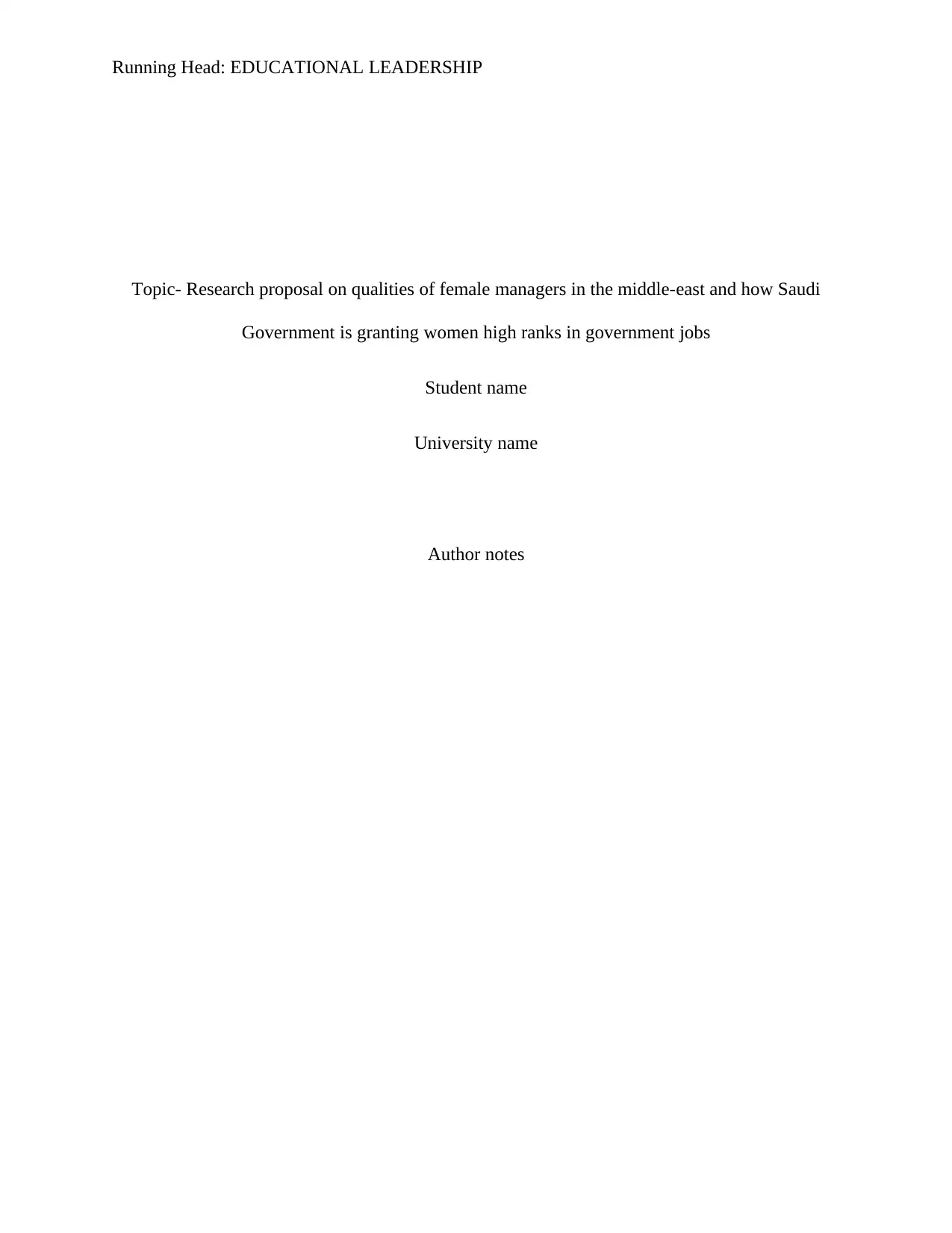
Running Head: EDUCATIONAL LEADERSHIP
Topic- Research proposal on qualities of female managers in the middle-east and how Saudi
Government is granting women high ranks in government jobs
Student name
University name
Author notes
Topic- Research proposal on qualities of female managers in the middle-east and how Saudi
Government is granting women high ranks in government jobs
Student name
University name
Author notes
Paraphrase This Document
Need a fresh take? Get an instant paraphrase of this document with our AI Paraphraser
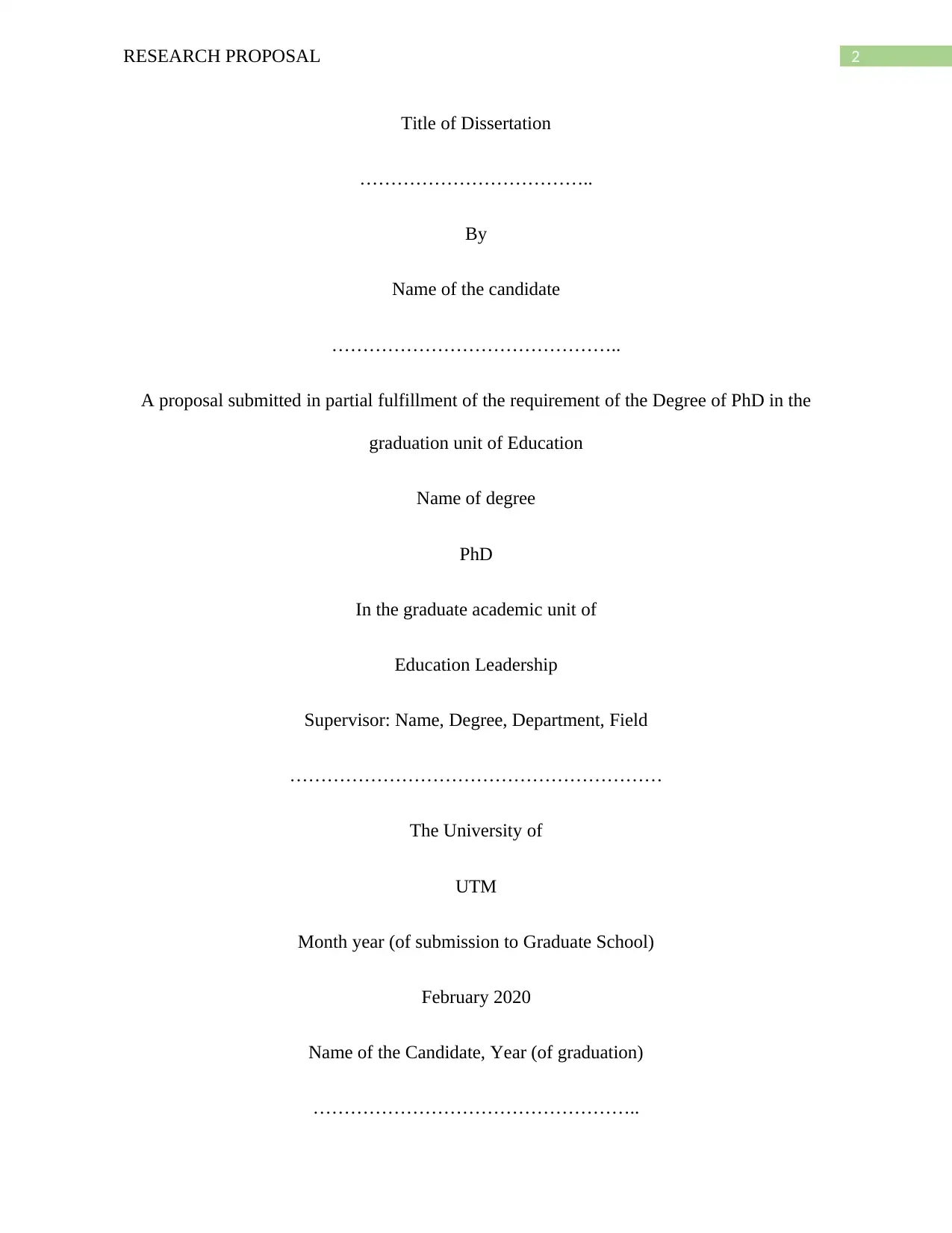
2RESEARCH PROPOSAL
Title of Dissertation
………………………………..
By
Name of the candidate
………………………………………..
A proposal submitted in partial fulfillment of the requirement of the Degree of PhD in the
graduation unit of Education
Name of degree
PhD
In the graduate academic unit of
Education Leadership
Supervisor: Name, Degree, Department, Field
……………………………………………………
The University of
UTM
Month year (of submission to Graduate School)
February 2020
Name of the Candidate, Year (of graduation)
……………………………………………..
Title of Dissertation
………………………………..
By
Name of the candidate
………………………………………..
A proposal submitted in partial fulfillment of the requirement of the Degree of PhD in the
graduation unit of Education
Name of degree
PhD
In the graduate academic unit of
Education Leadership
Supervisor: Name, Degree, Department, Field
……………………………………………………
The University of
UTM
Month year (of submission to Graduate School)
February 2020
Name of the Candidate, Year (of graduation)
……………………………………………..

3RESEARCH PROPOSAL
Abstract
We talk about Globalization, we talk about equal employment opportunities, we talk
about women empowerment, we also talk about female leadership, and at the same time we also
talk about Glass ceilings and Corporate Ladders. So, why this paradox? In this paper a
justification to this paradox is to be made from the perspectives of positions and qualities of
female managers in the Middle-East. Focus on women discrimination at workplaces and attitude
towards female managers is to be given along with how Governmental aids are being utilized in
motivating women high rankers in managerial positions emphasizing more on the vision 2030 by
Crown Prince. Not only from male-dominance perspectives but this paper will also highlight
how female managers treat their female employees and other female counterparts at workplaces.
Women empowerment will also be discussed with emphasis on cancer survivor women and also
on home-bound women who are willing to feel the spirit of own freedom and are looking for
career growth and opportunities. So, do glass ceiling really exist for women in top management,
is it a myth or is for real? Well, if one looks into the women employment conditions in the
Middle-east one can easily understand that there is a workplace disparity and that too with some
higher marginal differences. Gender role stereotyping is deeply obstinate in organizations
operating in the middle east nations. The paper thus discovers the place of women in strategic
management in Saudi Arabia and with the various challenges being faced by women in their
career paths. A semi-structured interview is conducted with 10 women managers, 2 cancer
survivors and 3 house-bound women who are willing to start their second innings of career
opportunities. Findings resulted from the interview sessions reveal that long working hours,
stereotypical behavior of the male dominated society, gender discrimination are the main reasons
for career hindrances. Society and culture also play major role in widening this disparity. Family
Abstract
We talk about Globalization, we talk about equal employment opportunities, we talk
about women empowerment, we also talk about female leadership, and at the same time we also
talk about Glass ceilings and Corporate Ladders. So, why this paradox? In this paper a
justification to this paradox is to be made from the perspectives of positions and qualities of
female managers in the Middle-East. Focus on women discrimination at workplaces and attitude
towards female managers is to be given along with how Governmental aids are being utilized in
motivating women high rankers in managerial positions emphasizing more on the vision 2030 by
Crown Prince. Not only from male-dominance perspectives but this paper will also highlight
how female managers treat their female employees and other female counterparts at workplaces.
Women empowerment will also be discussed with emphasis on cancer survivor women and also
on home-bound women who are willing to feel the spirit of own freedom and are looking for
career growth and opportunities. So, do glass ceiling really exist for women in top management,
is it a myth or is for real? Well, if one looks into the women employment conditions in the
Middle-east one can easily understand that there is a workplace disparity and that too with some
higher marginal differences. Gender role stereotyping is deeply obstinate in organizations
operating in the middle east nations. The paper thus discovers the place of women in strategic
management in Saudi Arabia and with the various challenges being faced by women in their
career paths. A semi-structured interview is conducted with 10 women managers, 2 cancer
survivors and 3 house-bound women who are willing to start their second innings of career
opportunities. Findings resulted from the interview sessions reveal that long working hours,
stereotypical behavior of the male dominated society, gender discrimination are the main reasons
for career hindrances. Society and culture also play major role in widening this disparity. Family
⊘ This is a preview!⊘
Do you want full access?
Subscribe today to unlock all pages.

Trusted by 1+ million students worldwide
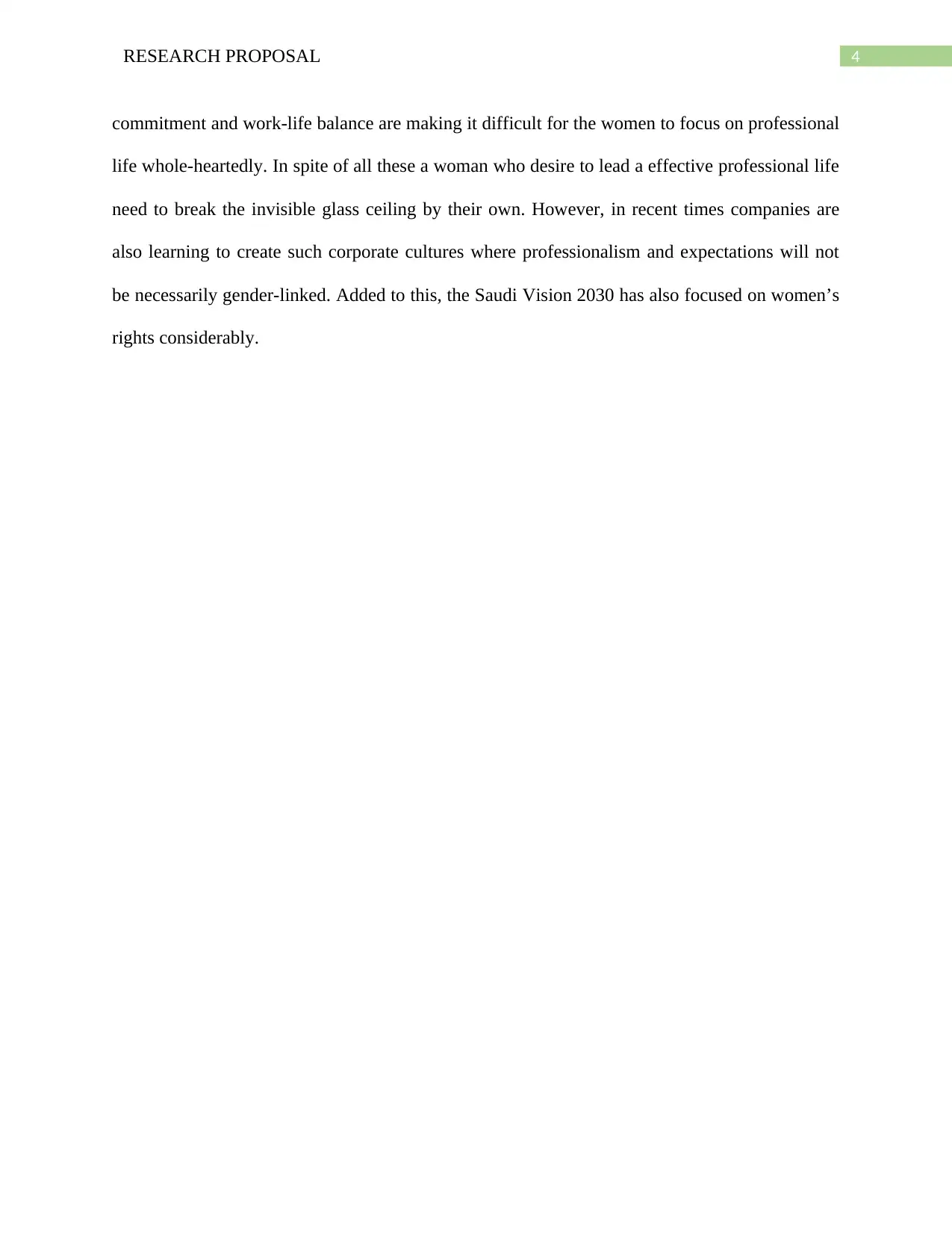
4RESEARCH PROPOSAL
commitment and work-life balance are making it difficult for the women to focus on professional
life whole-heartedly. In spite of all these a woman who desire to lead a effective professional life
need to break the invisible glass ceiling by their own. However, in recent times companies are
also learning to create such corporate cultures where professionalism and expectations will not
be necessarily gender-linked. Added to this, the Saudi Vision 2030 has also focused on women’s
rights considerably.
commitment and work-life balance are making it difficult for the women to focus on professional
life whole-heartedly. In spite of all these a woman who desire to lead a effective professional life
need to break the invisible glass ceiling by their own. However, in recent times companies are
also learning to create such corporate cultures where professionalism and expectations will not
be necessarily gender-linked. Added to this, the Saudi Vision 2030 has also focused on women’s
rights considerably.
Paraphrase This Document
Need a fresh take? Get an instant paraphrase of this document with our AI Paraphraser

5RESEARCH PROPOSAL
Table of contents
Chapter 1: Research orientation.......................................................................................................9
1.1 Introduction............................................................................................................................9
1.2 Rationale of the study............................................................................................................9
1.3 Background of the problem....................................................................................................9
1.4 Statement of the problem.....................................................................................................10
1.5 Significance of the study......................................................................................................10
1.6 Limitations of the study.......................................................................................................10
Chapter 2: Literature review..........................................................................................................12
2.1 Introduction..........................................................................................................................12
2.2 Background..........................................................................................................................12
2.3 Human Resource Theory.....................................................................................................13
2.4 Leadership Theory...............................................................................................................14
2.5 Psychology Theory..............................................................................................................14
2.6 Humanitarian Theory...........................................................................................................14
Chapter 3: Research Design and Methodology.............................................................................16
3.1 Introduction..........................................................................................................................16
3.2 Qualitative methods.............................................................................................................16
3.3 Definition of Grounded theory.............................................................................................16
3.4 Purpose of choosing Grounded theory for this study...........................................................16
3.5 Three principle aims of grounded theory in this study........................................................17
3.6 Participants...........................................................................................................................17
3.7 The semi-structured interview as a Qualitative Research Method......................................17
3.8 Data analysis methods..........................................................................................................17
3.9 Memo taking........................................................................................................................17
Chapter 5: Ethical considerations..................................................................................................19
Chapter 6: Summary......................................................................................................................19
Chapter 7: Proposed Chapters.......................................................................................................19
Bibliography..................................................................................................................................20
Appendix........................................................................................................................................22
Table of contents
Chapter 1: Research orientation.......................................................................................................9
1.1 Introduction............................................................................................................................9
1.2 Rationale of the study............................................................................................................9
1.3 Background of the problem....................................................................................................9
1.4 Statement of the problem.....................................................................................................10
1.5 Significance of the study......................................................................................................10
1.6 Limitations of the study.......................................................................................................10
Chapter 2: Literature review..........................................................................................................12
2.1 Introduction..........................................................................................................................12
2.2 Background..........................................................................................................................12
2.3 Human Resource Theory.....................................................................................................13
2.4 Leadership Theory...............................................................................................................14
2.5 Psychology Theory..............................................................................................................14
2.6 Humanitarian Theory...........................................................................................................14
Chapter 3: Research Design and Methodology.............................................................................16
3.1 Introduction..........................................................................................................................16
3.2 Qualitative methods.............................................................................................................16
3.3 Definition of Grounded theory.............................................................................................16
3.4 Purpose of choosing Grounded theory for this study...........................................................16
3.5 Three principle aims of grounded theory in this study........................................................17
3.6 Participants...........................................................................................................................17
3.7 The semi-structured interview as a Qualitative Research Method......................................17
3.8 Data analysis methods..........................................................................................................17
3.9 Memo taking........................................................................................................................17
Chapter 5: Ethical considerations..................................................................................................19
Chapter 6: Summary......................................................................................................................19
Chapter 7: Proposed Chapters.......................................................................................................19
Bibliography..................................................................................................................................20
Appendix........................................................................................................................................22
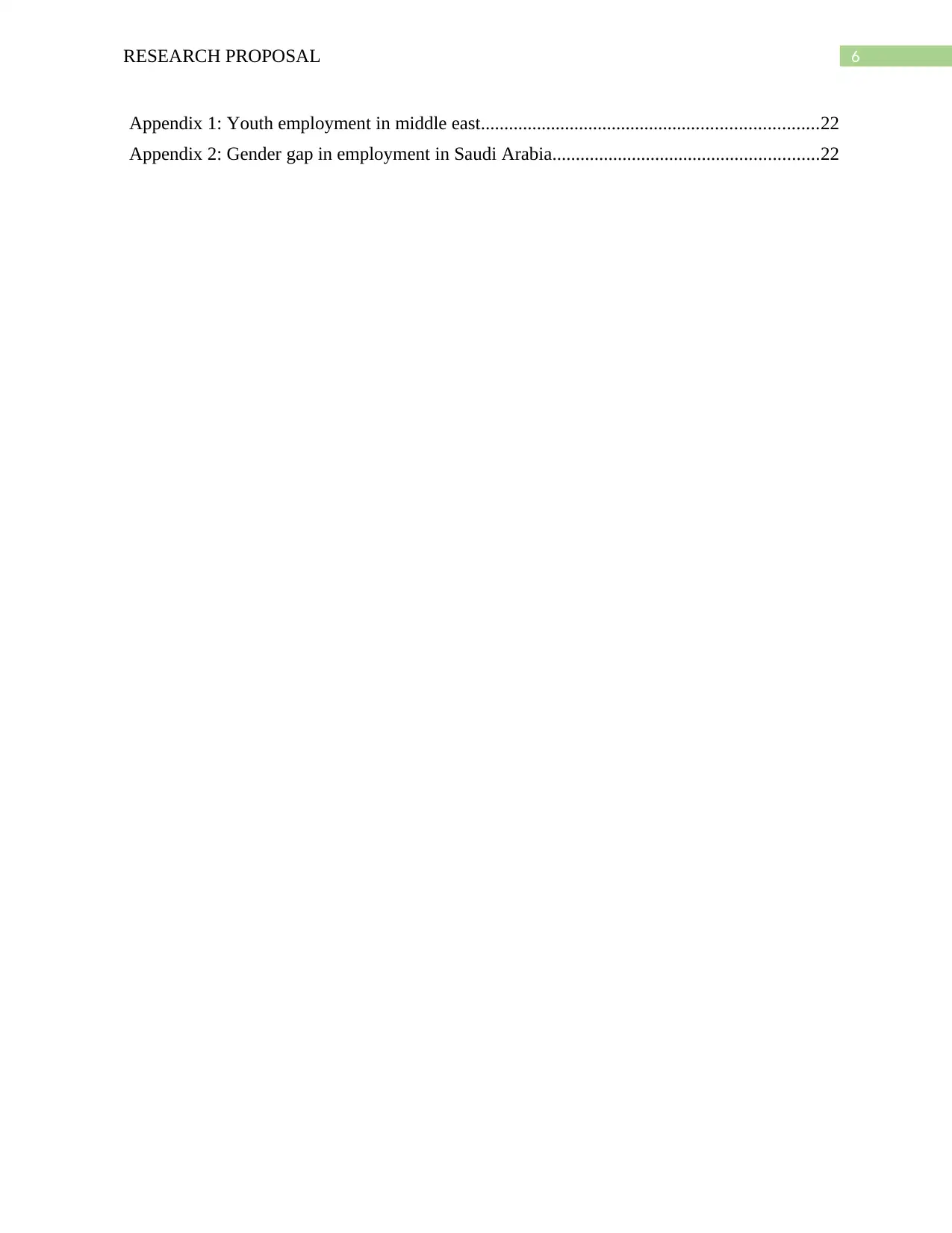
6RESEARCH PROPOSAL
Appendix 1: Youth employment in middle east........................................................................22
Appendix 2: Gender gap in employment in Saudi Arabia.........................................................22
Appendix 1: Youth employment in middle east........................................................................22
Appendix 2: Gender gap in employment in Saudi Arabia.........................................................22
⊘ This is a preview!⊘
Do you want full access?
Subscribe today to unlock all pages.

Trusted by 1+ million students worldwide
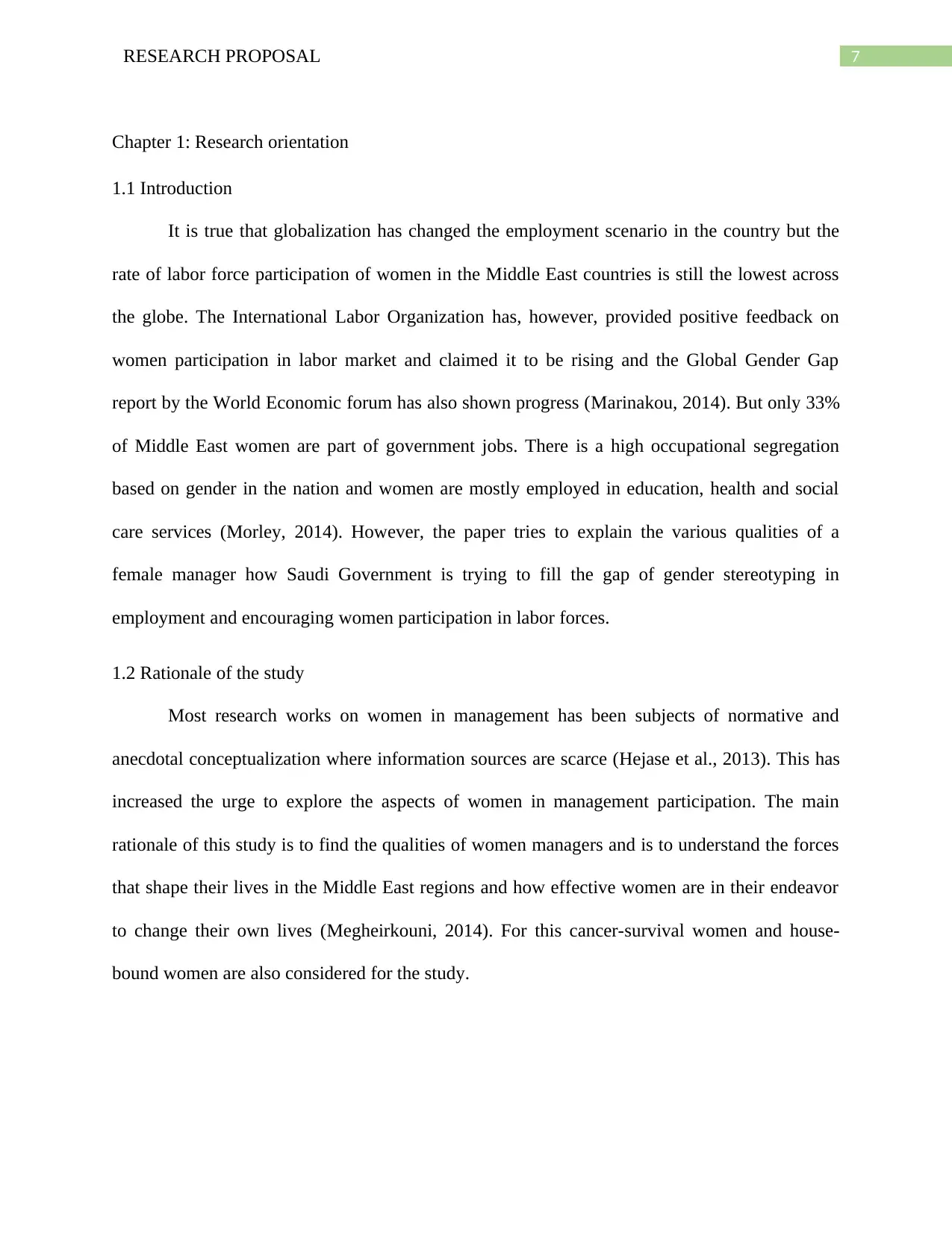
7RESEARCH PROPOSAL
Chapter 1: Research orientation
1.1 Introduction
It is true that globalization has changed the employment scenario in the country but the
rate of labor force participation of women in the Middle East countries is still the lowest across
the globe. The International Labor Organization has, however, provided positive feedback on
women participation in labor market and claimed it to be rising and the Global Gender Gap
report by the World Economic forum has also shown progress (Marinakou, 2014). But only 33%
of Middle East women are part of government jobs. There is a high occupational segregation
based on gender in the nation and women are mostly employed in education, health and social
care services (Morley, 2014). However, the paper tries to explain the various qualities of a
female manager how Saudi Government is trying to fill the gap of gender stereotyping in
employment and encouraging women participation in labor forces.
1.2 Rationale of the study
Most research works on women in management has been subjects of normative and
anecdotal conceptualization where information sources are scarce (Hejase et al., 2013). This has
increased the urge to explore the aspects of women in management participation. The main
rationale of this study is to find the qualities of women managers and is to understand the forces
that shape their lives in the Middle East regions and how effective women are in their endeavor
to change their own lives (Megheirkouni, 2014). For this cancer-survival women and house-
bound women are also considered for the study.
Chapter 1: Research orientation
1.1 Introduction
It is true that globalization has changed the employment scenario in the country but the
rate of labor force participation of women in the Middle East countries is still the lowest across
the globe. The International Labor Organization has, however, provided positive feedback on
women participation in labor market and claimed it to be rising and the Global Gender Gap
report by the World Economic forum has also shown progress (Marinakou, 2014). But only 33%
of Middle East women are part of government jobs. There is a high occupational segregation
based on gender in the nation and women are mostly employed in education, health and social
care services (Morley, 2014). However, the paper tries to explain the various qualities of a
female manager how Saudi Government is trying to fill the gap of gender stereotyping in
employment and encouraging women participation in labor forces.
1.2 Rationale of the study
Most research works on women in management has been subjects of normative and
anecdotal conceptualization where information sources are scarce (Hejase et al., 2013). This has
increased the urge to explore the aspects of women in management participation. The main
rationale of this study is to find the qualities of women managers and is to understand the forces
that shape their lives in the Middle East regions and how effective women are in their endeavor
to change their own lives (Megheirkouni, 2014). For this cancer-survival women and house-
bound women are also considered for the study.
Paraphrase This Document
Need a fresh take? Get an instant paraphrase of this document with our AI Paraphraser
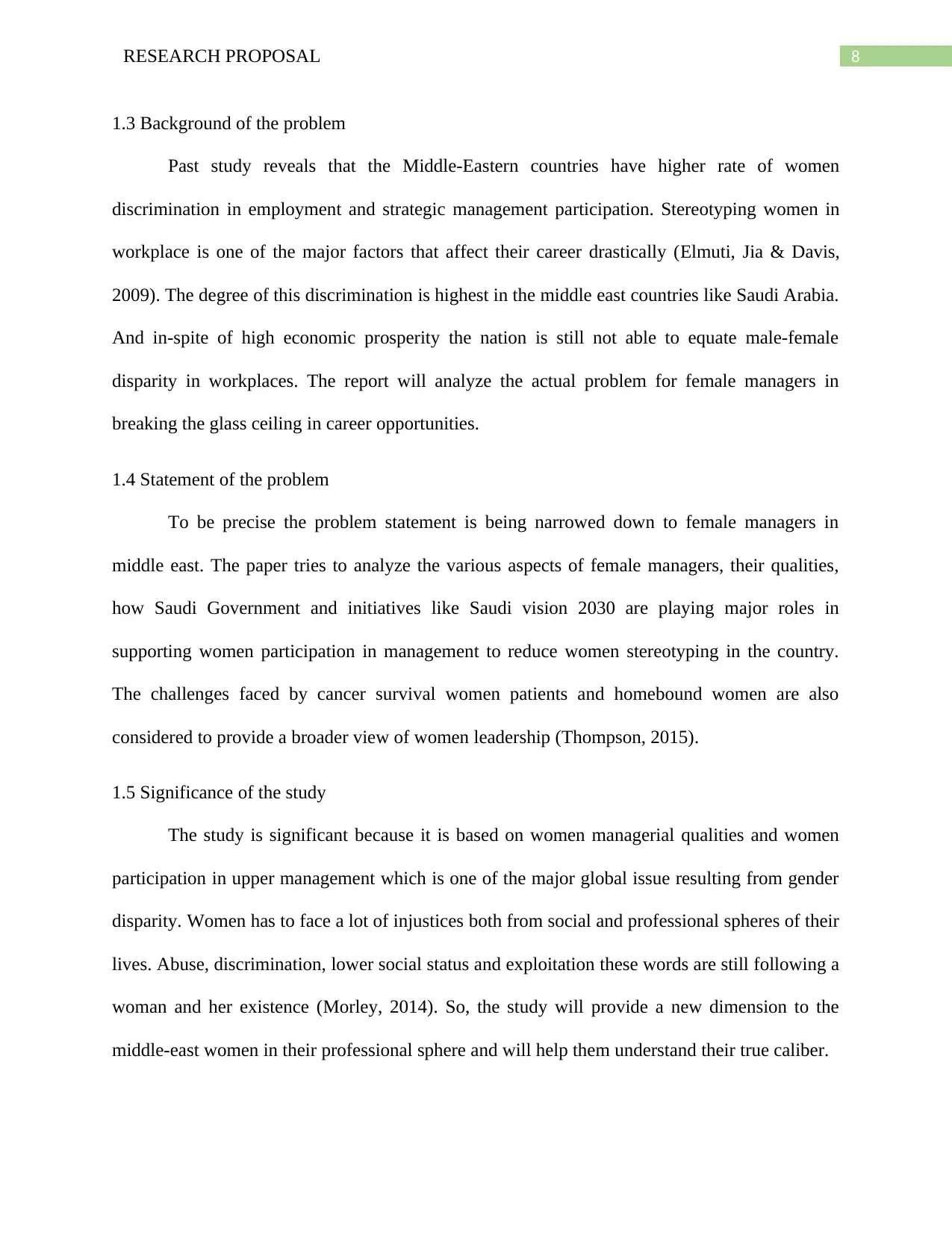
8RESEARCH PROPOSAL
1.3 Background of the problem
Past study reveals that the Middle-Eastern countries have higher rate of women
discrimination in employment and strategic management participation. Stereotyping women in
workplace is one of the major factors that affect their career drastically (Elmuti, Jia & Davis,
2009). The degree of this discrimination is highest in the middle east countries like Saudi Arabia.
And in-spite of high economic prosperity the nation is still not able to equate male-female
disparity in workplaces. The report will analyze the actual problem for female managers in
breaking the glass ceiling in career opportunities.
1.4 Statement of the problem
To be precise the problem statement is being narrowed down to female managers in
middle east. The paper tries to analyze the various aspects of female managers, their qualities,
how Saudi Government and initiatives like Saudi vision 2030 are playing major roles in
supporting women participation in management to reduce women stereotyping in the country.
The challenges faced by cancer survival women patients and homebound women are also
considered to provide a broader view of women leadership (Thompson, 2015).
1.5 Significance of the study
The study is significant because it is based on women managerial qualities and women
participation in upper management which is one of the major global issue resulting from gender
disparity. Women has to face a lot of injustices both from social and professional spheres of their
lives. Abuse, discrimination, lower social status and exploitation these words are still following a
woman and her existence (Morley, 2014). So, the study will provide a new dimension to the
middle-east women in their professional sphere and will help them understand their true caliber.
1.3 Background of the problem
Past study reveals that the Middle-Eastern countries have higher rate of women
discrimination in employment and strategic management participation. Stereotyping women in
workplace is one of the major factors that affect their career drastically (Elmuti, Jia & Davis,
2009). The degree of this discrimination is highest in the middle east countries like Saudi Arabia.
And in-spite of high economic prosperity the nation is still not able to equate male-female
disparity in workplaces. The report will analyze the actual problem for female managers in
breaking the glass ceiling in career opportunities.
1.4 Statement of the problem
To be precise the problem statement is being narrowed down to female managers in
middle east. The paper tries to analyze the various aspects of female managers, their qualities,
how Saudi Government and initiatives like Saudi vision 2030 are playing major roles in
supporting women participation in management to reduce women stereotyping in the country.
The challenges faced by cancer survival women patients and homebound women are also
considered to provide a broader view of women leadership (Thompson, 2015).
1.5 Significance of the study
The study is significant because it is based on women managerial qualities and women
participation in upper management which is one of the major global issue resulting from gender
disparity. Women has to face a lot of injustices both from social and professional spheres of their
lives. Abuse, discrimination, lower social status and exploitation these words are still following a
woman and her existence (Morley, 2014). So, the study will provide a new dimension to the
middle-east women in their professional sphere and will help them understand their true caliber.
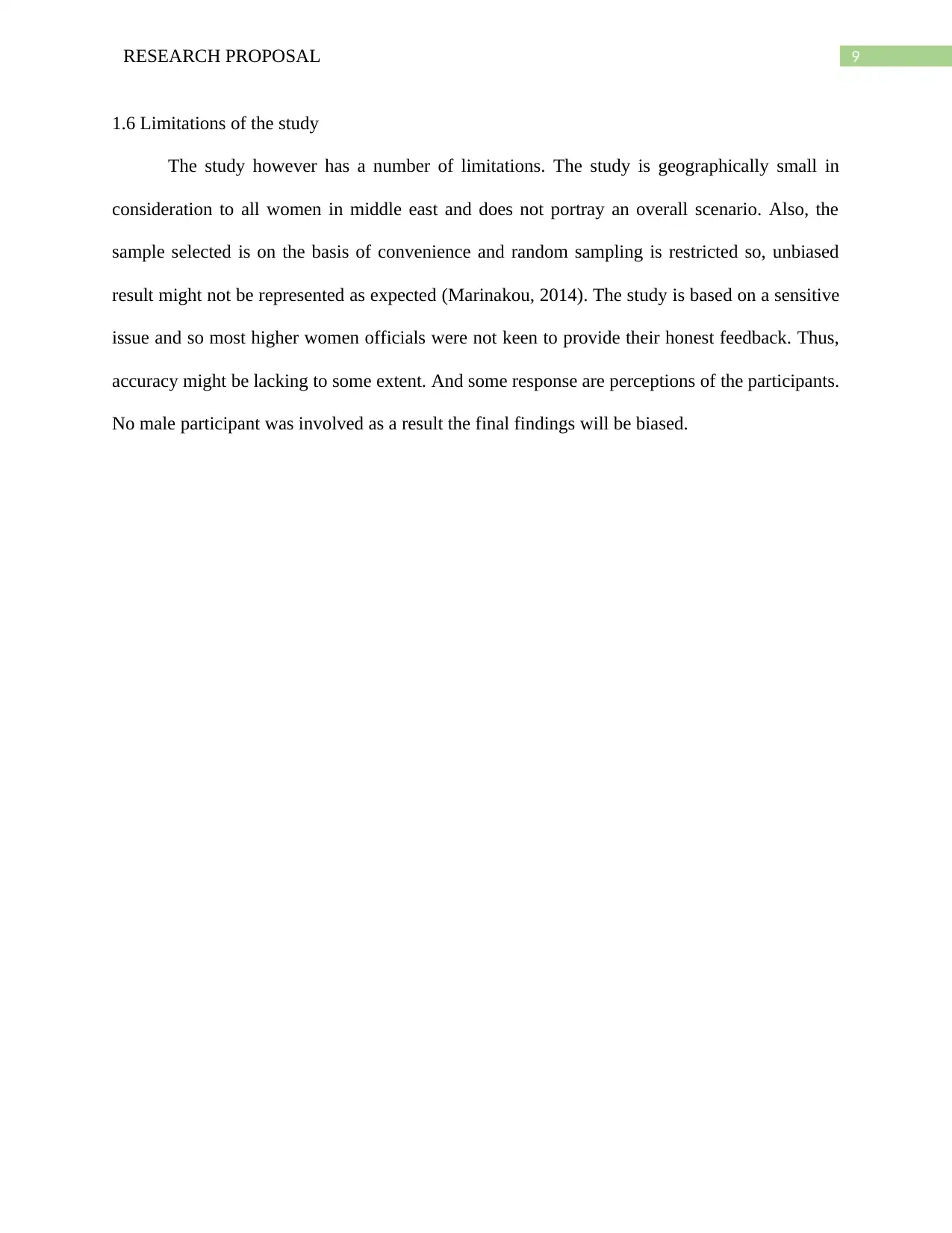
9RESEARCH PROPOSAL
1.6 Limitations of the study
The study however has a number of limitations. The study is geographically small in
consideration to all women in middle east and does not portray an overall scenario. Also, the
sample selected is on the basis of convenience and random sampling is restricted so, unbiased
result might not be represented as expected (Marinakou, 2014). The study is based on a sensitive
issue and so most higher women officials were not keen to provide their honest feedback. Thus,
accuracy might be lacking to some extent. And some response are perceptions of the participants.
No male participant was involved as a result the final findings will be biased.
1.6 Limitations of the study
The study however has a number of limitations. The study is geographically small in
consideration to all women in middle east and does not portray an overall scenario. Also, the
sample selected is on the basis of convenience and random sampling is restricted so, unbiased
result might not be represented as expected (Marinakou, 2014). The study is based on a sensitive
issue and so most higher women officials were not keen to provide their honest feedback. Thus,
accuracy might be lacking to some extent. And some response are perceptions of the participants.
No male participant was involved as a result the final findings will be biased.
⊘ This is a preview!⊘
Do you want full access?
Subscribe today to unlock all pages.

Trusted by 1+ million students worldwide
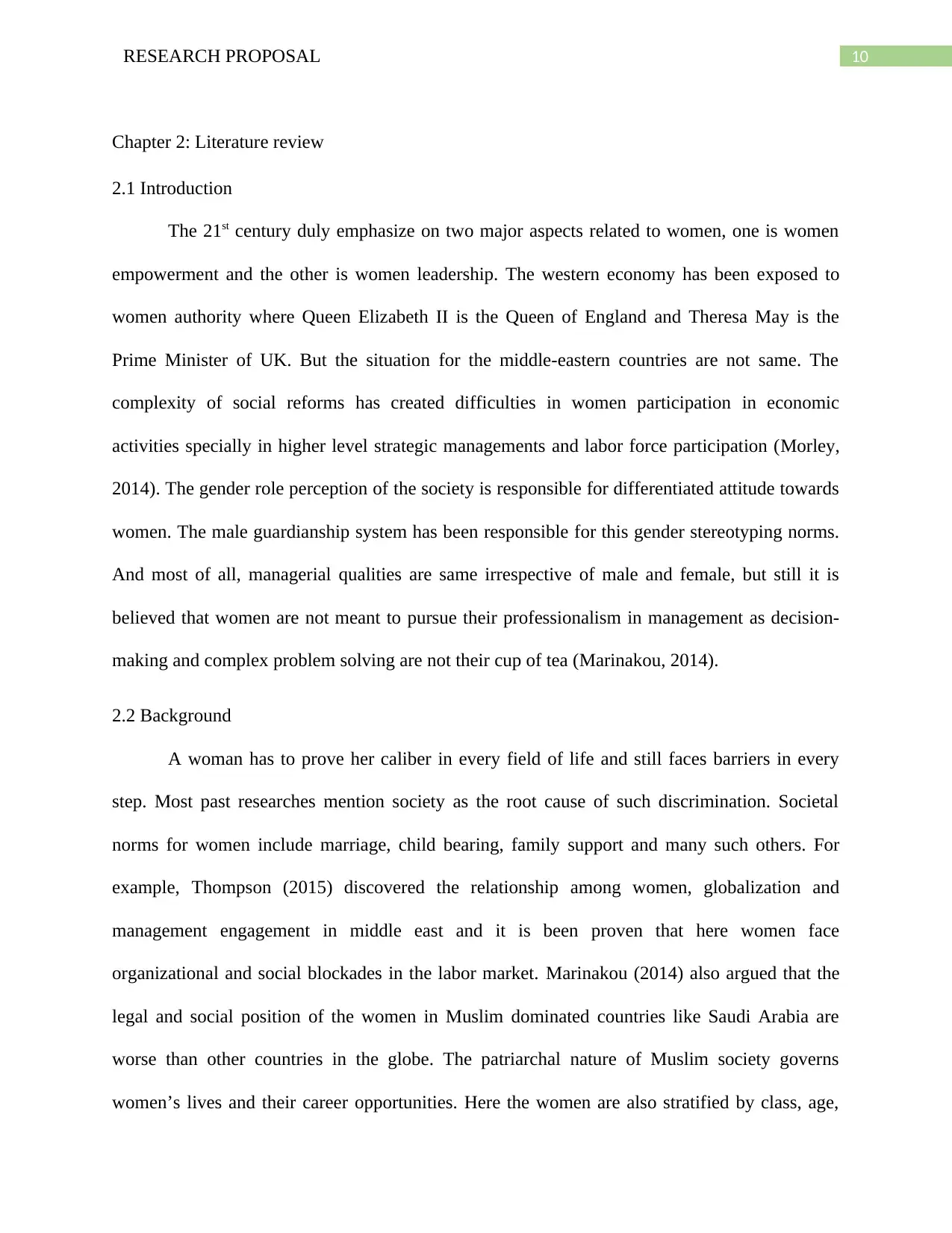
10RESEARCH PROPOSAL
Chapter 2: Literature review
2.1 Introduction
The 21st century duly emphasize on two major aspects related to women, one is women
empowerment and the other is women leadership. The western economy has been exposed to
women authority where Queen Elizabeth II is the Queen of England and Theresa May is the
Prime Minister of UK. But the situation for the middle-eastern countries are not same. The
complexity of social reforms has created difficulties in women participation in economic
activities specially in higher level strategic managements and labor force participation (Morley,
2014). The gender role perception of the society is responsible for differentiated attitude towards
women. The male guardianship system has been responsible for this gender stereotyping norms.
And most of all, managerial qualities are same irrespective of male and female, but still it is
believed that women are not meant to pursue their professionalism in management as decision-
making and complex problem solving are not their cup of tea (Marinakou, 2014).
2.2 Background
A woman has to prove her caliber in every field of life and still faces barriers in every
step. Most past researches mention society as the root cause of such discrimination. Societal
norms for women include marriage, child bearing, family support and many such others. For
example, Thompson (2015) discovered the relationship among women, globalization and
management engagement in middle east and it is been proven that here women face
organizational and social blockades in the labor market. Marinakou (2014) also argued that the
legal and social position of the women in Muslim dominated countries like Saudi Arabia are
worse than other countries in the globe. The patriarchal nature of Muslim society governs
women’s lives and their career opportunities. Here the women are also stratified by class, age,
Chapter 2: Literature review
2.1 Introduction
The 21st century duly emphasize on two major aspects related to women, one is women
empowerment and the other is women leadership. The western economy has been exposed to
women authority where Queen Elizabeth II is the Queen of England and Theresa May is the
Prime Minister of UK. But the situation for the middle-eastern countries are not same. The
complexity of social reforms has created difficulties in women participation in economic
activities specially in higher level strategic managements and labor force participation (Morley,
2014). The gender role perception of the society is responsible for differentiated attitude towards
women. The male guardianship system has been responsible for this gender stereotyping norms.
And most of all, managerial qualities are same irrespective of male and female, but still it is
believed that women are not meant to pursue their professionalism in management as decision-
making and complex problem solving are not their cup of tea (Marinakou, 2014).
2.2 Background
A woman has to prove her caliber in every field of life and still faces barriers in every
step. Most past researches mention society as the root cause of such discrimination. Societal
norms for women include marriage, child bearing, family support and many such others. For
example, Thompson (2015) discovered the relationship among women, globalization and
management engagement in middle east and it is been proven that here women face
organizational and social blockades in the labor market. Marinakou (2014) also argued that the
legal and social position of the women in Muslim dominated countries like Saudi Arabia are
worse than other countries in the globe. The patriarchal nature of Muslim society governs
women’s lives and their career opportunities. Here the women are also stratified by class, age,
Paraphrase This Document
Need a fresh take? Get an instant paraphrase of this document with our AI Paraphraser

11RESEARCH PROPOSAL
ethnicity and education. Many private companies are reluctant in considering women as a part of
their workforce mainly because of this class disparity and also for the additional cost that need to
be incurred as a part of their maternity provision (Morley, 2014). However, recent social changes
have made women more independent and present-day Saudi women cannot be referred to as
inferior, scared or domestic women.
2.3 Human Resource Theory
Managerial qualities are not segregated based on gender differences. Talking about
leadership as the main role it is quite evident that middle-east women struggle to taken on any
leadership role over traditionally male dominated work front. The quality of life an Arab woman
will lead is still under huge controversy where some believe that they are good at homes, some
believe that women are meant to look after the family and children and some also argue that
Arab women need to be empowered (Morley, 2014). Arab women are more active in the
transformational leadership scale of intellectual stimulation, idealized influence, inspirational
motivation and individualized considerations (Thompson, 2015). A real-life example will
support the struggle a woman has to face in reaching a managerial position and also there itself.
Sheikha Lubna Al Qassimi, IT strategy Head at Dubai Ports World, was the first female
executive in the male dominated maritime industry. She agreed that reaching to the board was
really tough and full of challenges. She mentioned that her reliability and trustworthiness of her
decisions were always questioned. Now, she is the Minister of foreign Trades for UAE and is the
most powerful women of Arab World (Thompson, 2015). She is the representative of the small
but significant women group in the middle east who are defying expectations and creating the
ultimate difference to the Gulf Corporation Counicl Countries. So, for women to be accepted in
workplaces first they need to be trusted and second, they need to be over achievers.
ethnicity and education. Many private companies are reluctant in considering women as a part of
their workforce mainly because of this class disparity and also for the additional cost that need to
be incurred as a part of their maternity provision (Morley, 2014). However, recent social changes
have made women more independent and present-day Saudi women cannot be referred to as
inferior, scared or domestic women.
2.3 Human Resource Theory
Managerial qualities are not segregated based on gender differences. Talking about
leadership as the main role it is quite evident that middle-east women struggle to taken on any
leadership role over traditionally male dominated work front. The quality of life an Arab woman
will lead is still under huge controversy where some believe that they are good at homes, some
believe that women are meant to look after the family and children and some also argue that
Arab women need to be empowered (Morley, 2014). Arab women are more active in the
transformational leadership scale of intellectual stimulation, idealized influence, inspirational
motivation and individualized considerations (Thompson, 2015). A real-life example will
support the struggle a woman has to face in reaching a managerial position and also there itself.
Sheikha Lubna Al Qassimi, IT strategy Head at Dubai Ports World, was the first female
executive in the male dominated maritime industry. She agreed that reaching to the board was
really tough and full of challenges. She mentioned that her reliability and trustworthiness of her
decisions were always questioned. Now, she is the Minister of foreign Trades for UAE and is the
most powerful women of Arab World (Thompson, 2015). She is the representative of the small
but significant women group in the middle east who are defying expectations and creating the
ultimate difference to the Gulf Corporation Counicl Countries. So, for women to be accepted in
workplaces first they need to be trusted and second, they need to be over achievers.

12RESEARCH PROPOSAL
2.4 Leadership Theory
The transformational women leaders are the most successful where they focus three
things of constant improvement, studied discomfort and quiet confidence (Marinakou, 2014).
Women managers who refuse to accept the prevalent status quo are the ones who manifest
themselves to success. The women who have the willingness to move out of their comfort zone
both personally and professionally are the ones who love accepting challenges and are best fitted
to their organizational job roles (Morley, 2014). Self-confidence and certainty in one’s own
abilities help women prepare themselves for their work.
2.5 Psychology Theory
Again, psychology will help in understanding the attitude of female managers towards
their female counterparts. Generally, a woman manager is more dominating and systematic in
their approach than a male one and treat their subordinates in a very strict fashion (Marinakou,
2014). Empathy is less and they became extra proud of their managerial positions. Also, at times
it is argued that a woman manager will provide extra advantage to her female sub-ordinate which
may not be the actual case. So, what exactly should be the attitude that cannot be defined in
reality but yes, the organizational cultural positivism should be kept intact.
2.6 Humanitarian Theory
The condition of cancer survivors, specially breast cancer survivors, is much painful
where the society treats them as weaker sections and provide sympathy and show support for
their bravery. But when it comes to workplace environment the situation changes and they are
discriminated as weaker societal sections and instead of having all caliber, they are excluded
from achieving high on their careers (Chouchane, Boussen & Sastry, 2013). Same is the case for
housebound females who have decided to start the next phase of their career. They are also
2.4 Leadership Theory
The transformational women leaders are the most successful where they focus three
things of constant improvement, studied discomfort and quiet confidence (Marinakou, 2014).
Women managers who refuse to accept the prevalent status quo are the ones who manifest
themselves to success. The women who have the willingness to move out of their comfort zone
both personally and professionally are the ones who love accepting challenges and are best fitted
to their organizational job roles (Morley, 2014). Self-confidence and certainty in one’s own
abilities help women prepare themselves for their work.
2.5 Psychology Theory
Again, psychology will help in understanding the attitude of female managers towards
their female counterparts. Generally, a woman manager is more dominating and systematic in
their approach than a male one and treat their subordinates in a very strict fashion (Marinakou,
2014). Empathy is less and they became extra proud of their managerial positions. Also, at times
it is argued that a woman manager will provide extra advantage to her female sub-ordinate which
may not be the actual case. So, what exactly should be the attitude that cannot be defined in
reality but yes, the organizational cultural positivism should be kept intact.
2.6 Humanitarian Theory
The condition of cancer survivors, specially breast cancer survivors, is much painful
where the society treats them as weaker sections and provide sympathy and show support for
their bravery. But when it comes to workplace environment the situation changes and they are
discriminated as weaker societal sections and instead of having all caliber, they are excluded
from achieving high on their careers (Chouchane, Boussen & Sastry, 2013). Same is the case for
housebound females who have decided to start the next phase of their career. They are also
⊘ This is a preview!⊘
Do you want full access?
Subscribe today to unlock all pages.

Trusted by 1+ million students worldwide
1 out of 21
Your All-in-One AI-Powered Toolkit for Academic Success.
+13062052269
info@desklib.com
Available 24*7 on WhatsApp / Email
![[object Object]](/_next/static/media/star-bottom.7253800d.svg)
Unlock your academic potential
Copyright © 2020–2025 A2Z Services. All Rights Reserved. Developed and managed by ZUCOL.
